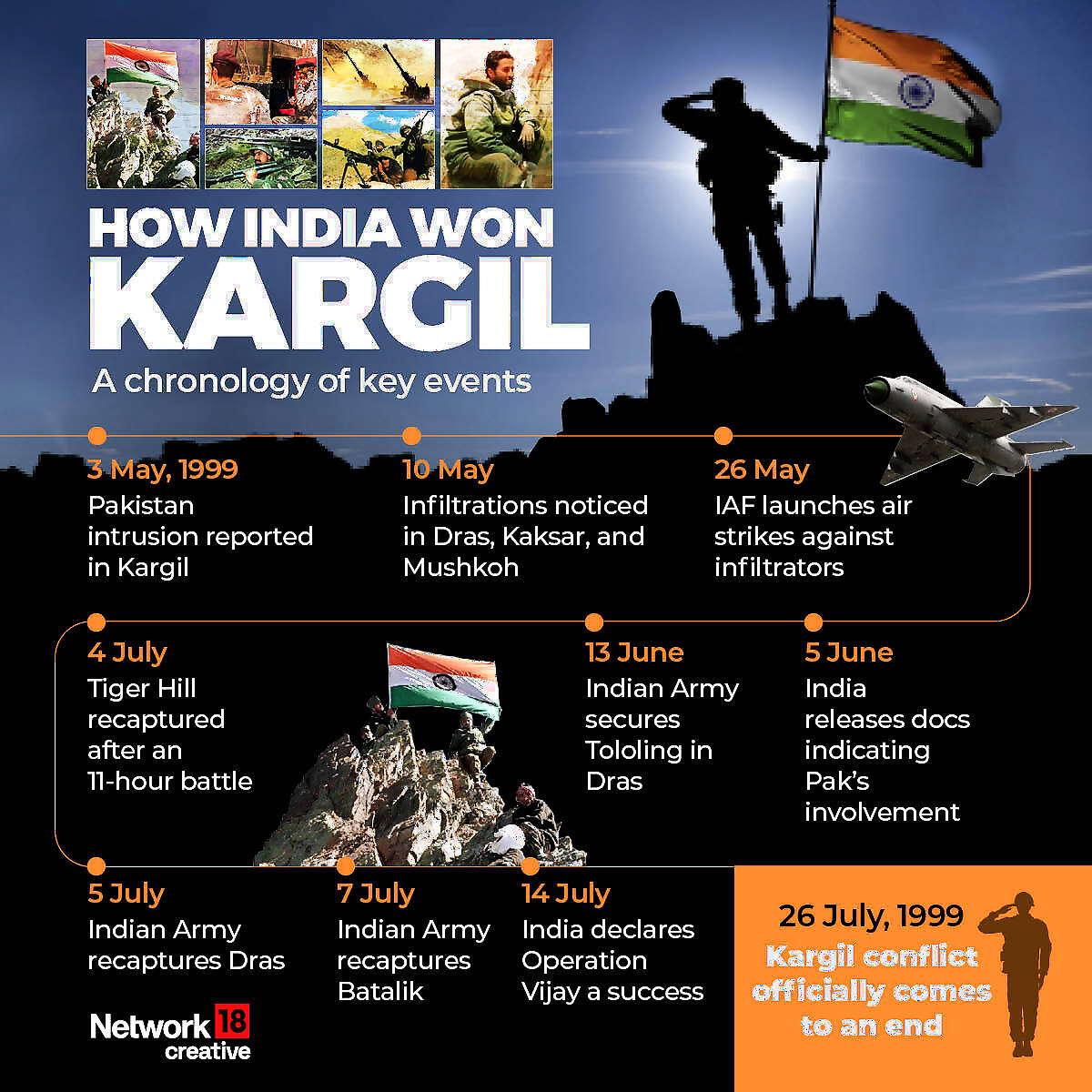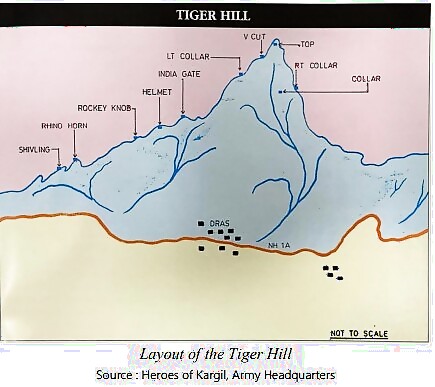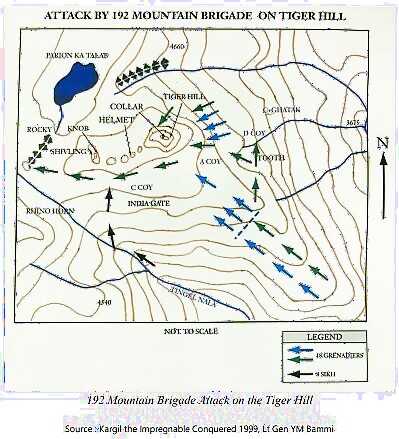
views
PM Narendra Modi on Friday paid homage to the Kargil War bravehearts at the Drass War Memorial to commemorate the 25th anniversary of India’s victory over Pakistan in the 1999 war.
On July 26, 1999, the Indian Army announced the successful culmination of ‘Operation Vijay’, declaring victory after a nearly three-month-long battle on the icy heights of Kargil in Ladakh. The day is observed as ‘Kargil Vijay Diwas’ to commemorate India’s victory over Pakistan in the war.
India fought some of the most intense battles during the Kargil War, in one of the most challenging terrains in the world. After a fierce battle in Tololing and successfully capturing the summit, the focus shifted to Tiger Hill, which towers above all other mountains in its vicinity of Drass village in the Ladakh region.
Here’s all you need to know about the Kargil war and Tiger Hill battle:
OPERATION VIJAY
In 1998-99 winter, Pakistan Armed Forces were covertly training and infiltrating Pakistani troops and paramilitary forces towards the Indian side of the Line of Control (LoC). The infiltration was codenamed “Operation Badr” and the aim was to sever the link between Kashmir and Ladhak and cause Indian forces to withdraw from the Siachen Glaciers, forcing India to negotiate a settlement of the broader Kashmir dispute.
Pakistan also believed that any tension in the region would internationalize the Kashmir issue, helping it to secure a speedy resolution. The infiltration began even after India and Pakistan signed the Lahore Declaration in February, 1999 in which both the countries mutually agreed to solve the Kashmir issue in a peaceful manner among others. Soon the Pakistani troops managed to capture a region between 130 to 200 square kilometres.
Seeing the Pakistani troops infiltrating the Indian side, the Indian Armed Forces started to respond with Operation Vijay. The plan of Pakistan was to send its soldiers during the winters when India vacated certain posts.
The glorious Operation Vijay saw the mobilisation of about 2,00,000 Indian troops and brought a swift and final end to the war by recapturing all the previously lost posts and forcing the Pakistani intruders to vacate the posts.

THE BATTLE OF TIGER HILL
According to the Defence Ministry’s website, in the winter of 1998, Pakistani intruders occupied positions on this mountain, thus dominating portions of the Srinagar-Leh NH 1A. Almost 10 km to the north of the highway, Tiger Hills facilitated a commanding view of the National Highway, which aided the Pakistani artillery Observation Post officers to direct accurate artillery fire onto the NH 1A. NH 1A is a strategic route to Siachen Glacier and connects Srinagar to Leh in Ladakh. It was estimated that the enemy had about 40 soldiers deployed on Tiger Hill and some additional troops were seen moving in the nearby areas.
192 Mountain Brigade arrived in Drass from the Valley and was placed under command of 8 Mountain Division headed by Major General Mohinder Puri. 18 Grenadiers were tasked to evict the enemy and recapture the peak at earliest. General Puri placed them under Headquarters 192 Mountain Brigade along with 13 JAK RIF.

ON JULY 3
At the designated time of 2000 hours on July 3, the soldiers of 18 Grenadiers embarked on their mission. Major RS Rathore led his A Company towards the designated area known as Tongue, and successfully captured it.
Meanwhile, under the leadership of Lieutenant Balwan Singh, the Commando Platoon advanced, coming close to the summit of Tiger Hill. Lieutenant Balwan Singh and his platoon were gradually pushed back, ultimately finding safety at the position held by D Company, which lay a mere 30 metres away from the pinnacle of Tiger Hill.

ON JULY 4/5
On the night of July 4/5, the fire bases moved forward to a position just short of Tiger Hill Top where they were grouped under Officer Commanding (OC) C Company, Colonel (then Major) Mijar Captain Nimbalkar, accompanied by D Company and the Commando Platoon, silently ascended the uphill terrain, successfully reaching the pinnacle of Tiger Hill. Despite being wounded, Lieutenant Balwan Singh led his platoon. Grenadier Yogendra Singh Yadav, the lead Ghatak, confronted the advancing counter attack despite sustaining injuries, successfully neutralising two enemy combatants. Grenadier Yogendra Singh Yadav hurled a grenade into the sangar, successfully neutralising four additional enemy combatants with his assault rifle. However, due to his sustained injuries, he eventually collapsed. Pakistani soldiers fired at the dead bodies. Grenadier Yadav received nine bullet wounds, but was still alive and remained silent, listening to the plans of the Pakistani soldiers.
In the quest to pass that information on, he crawled as he made his way through to Captain Nimbalkar’s position and collapsed again. For this heroic act, he was awarded the highest gallantry award — the Param Vir Chakra.
#KargilVijayDiwas2024 LIVE | “Your nefarious intentions will never succeed. Our soldiers will crush #terrorism with full force…”PM Narendra Modi sends a strong message to #Pakistan from #Ladakh. #Watch #LIVE– https://t.co/BlHrlvkPtZ pic.twitter.com/C8iNNe1CCW
— News18 (@CNNnews18) July 26, 2024
JULY 5/6
Brigadier Bajwa gave orders for 8 Sikh to reinforce the foothold that Subedar Nirmal Singh had established on Helmet. In response, Lieutenant RK Sherawat, accompanied by a small group of men, moved up to the area on July 5 and 6. Captain Nope Singh joined Lieutenant Sherawat on July 6. Together, they had a strength of about 70 soldiers. These troops positioned themselves between the Top and the Tongue. Under heavy fire, Colonel SP Singh, the Commanding Officer (CO) of 8 Sikh, addressed his men, urging them to hold their ground and maintain their positions against the enemy’s assault. Surprising the enemy with their swift and determined action, 8 Sikh successfully recaptured Helmet, forcing the enemy to retreat to Shivling and Point 5060. The opposing forces still held strategic positions on the western slope and the Collar.
ON JULY 6/7/8
On the night of July 6-7, 18 Grenadiers secured the Top and the Tongue — two key positions. The following night, between July 7 and 8, they successfully cleared out the enemy from the reverse slopes of Top. Simultaneously, B Company was assigned the task of linking up with Top from the eastern direction. In the South, A Company captured the area known as Collar, further expanding the control of friendly forces. Meanwhile, Captain Das Gupta, leading C Company along with the Ghataks, undertook the mission to capture Rocky Knob. With coordinated efforts, all the companies managed to link up with each other, establishing a unified front. By 0800h, the strategically significant Tiger Hill was secured.
In this battle, India lost nine soldiers who made the ultimate sacrifice. In the line of duty, one officer, four Junior Commissioned Officers (JCOs), and 32 soldiers sustained injuries during the battle.



















Comments
0 comment